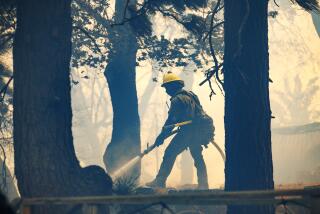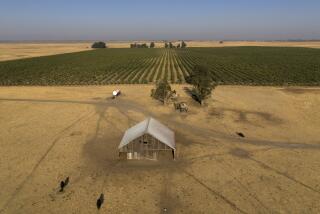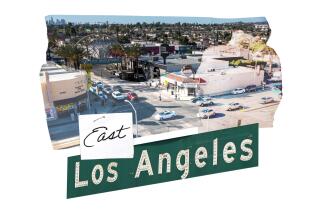Talk of Cityhood Again Sends Ripples of Opinion Through Lake Resort : Home rule: Differences on keeping Arrowhead area pristine are raised with bid to incorporate nine villages.
LAKE ARROWHEAD — It was the piney woods, smog-free air and uncrowded spaces that drew insurance man Jack Marley here from Orange County 2 1/2 years ago. That same enticing combination also captured the heart of Larry Brown, a real estate broker who settled in this resort community in the mid-1970s.
But while both men share a passion for the mountain lifestyle they have adopted, they part ways on one crucial question--how best to preserve it.
Marley thinks incorporation is the answer. A local City Council, he argues, would be more responsive to residents than a lone county supervisor with an office down in the flatlands of San Bernardino 20 miles away.
For Brown, however, the notion of city government conjures up images of parking meters and street lights, of special fees and assessments and “somebody always breathing down your neck.” Mountain dwellers, he believes, moved to Arrowhead to “get close to nature” and escape such things.
All around this frosty resort--in the post office, the grocery stores and at the library--arguments like those voiced by Marley and Brown can be heard. Signatures are now being gathered to put the question of cityhood to a vote, and everybody, it seems, has an opinion on the matter.
Marley is co-chairman of a committee promoting incorporation for the Lake Arrowhead Village area--and the handful of other forested villages scattered around the lake. Under the group’s proposal, a city of 14,700 people would be created through the wedding of nine small communities encompassing about 17 square miles.
This isn’t the first time talk of home rule has surfaced here. Incorporation petitions were circulated in the area eight years ago, but proponents could not collect enough valid signatures to qualify the question for the ballot.
Things have changed since then, however, and a lot of it has to do with growth. In Lake Arrowhead the population has tripled since 1980, with most of the newcomers arriving in the last five years. Neighboring hamlets have experienced a similar surge, and local real estate brokers say brisk lot sales indicate the trend will continue.
A majority of homeowners are now choosing to live full-time in the mountains. As a result, the Arrowhead area is evolving from a vacation retreat, whose population dipped and soared with the seasons, to a mile-high bedroom community with residents who commute to jobs throughout the Inland Empire.
“We’re a maturing, growing community and it’s time we took responsibility for controlling our own destiny,” said John Dunzer, an Arrowhead resident and business consultant who prepared a study that shows the area generates ample tax dollars to support a city government.
“We’ve got a tremendous opportunity here to do something really beneficial for the community with virtually no financial risk. The question is whether people will recognize the positives and get behind it.”
Proponents call cityhood a no-lose proposition, a safe way to improve services, control development and place the reins of government in the hands of people who rent their video movies at the same place as those who elect them.
Life under county rule, they argue, is less than ideal. There aren’t enough sheriff’s deputies and they don’t respond quickly enough, they say. The lumbering snow plows often arrive many days late to clear the roads after a big storm. And code enforcement is poor, they say, while standards for new construction are sometimes lax.
Finally, Marley and others say, San Bernardino County Supervisor Marsha Turoci--while sensitive to the needs of her mountain constituents--has a giant district and is simply stretched too thin.
“People say (cityhood) is just another layer of government, but it’s not. It’s a better layer of government,” said Tony West, who owns a Los Angeles box company and has made Arrowhead his home for 10 years. “When we have problems with services now, we have very little recourse. With a city, we can elect people who can shout and fight it out locally.”
Another key attraction of incorporation, supporters argue, is the ability to keep local sales and bed tax revenues within the community. Currently, the mountain towns get back about $2 worth of services for every $3 in revenue they contribute to county coffers, Dunzer estimates. Cityhood would enable all locally generated money to be spent on local problems, resulting in improved services, Dunzer said.
Moreover, after the first full operating year, the proposed city would have a budget surplus of $1.3 million, Dunzer’s study predicts.
“There’s absolutely no question that we’re getting shortchanged--putting in more than we get back from the county (in services),” Dunzer said. “If we were a city, that would end. . . . The financial picture looks very, very bright.”
Others, however, aren’t so sure, and opposition to the idea seems to be spreading across the mountains like a fast-moving thunderhead. For Larry Brown, cityhood means structure--something he believes mountain folks would just as soon do without.
“We all came up here because we wanted to get away from cities, from all the rules and all the people hounding you and telling you, ‘Don’t do this, don’t do that,’ ” said Brown, president of Save Our Forest Assn., a land preservation group. “The county has been in the business of governing this place for years and years, and I think they’re doing OK. You know the saying, ‘If it works, don’t try to fix it.’ ”
Other opponents chafe at the idea of combining nine villages--all of which have distinct personalities--into one big city. Although proponents point out that La Jolla remains distinct from its mother city, San Diego, incorporation foes worry that they would be swallowed up by Arrowhead and their uniqueness lost.
“I live in Cedar Glen and I like it that way,” said John Geiger, a local contractor and 23-year mountain resident. “Put us in some city called Lake Arrowhead and you get a loss of identity. That doesn’t sit well with me.”
In addition, some residents in the outlying communities--which have median family incomes far below those in Lake Arrowhead--fear incorporation might be some sort of power grab by the richer lakeside community.
On the other end of the spectrum, some wealthy Arrowhead residents worry that cityhood might affect the status of the lake, which is privately owned by homeowners in certain neighborhoods along the 12-mile shoreline. Access to the lake has long been a point of dispute among mountain dwellers, and some people with lake rights fear a City Council might have the power to tamper with the current ownership arrangement.
“There’s a lot of suspicion out there, and a real groundswell of resentment,” Brown said. “People up here are pretty independent, and they feel threatened by this.”
To lessen such fears, pro-incorporation forces are distributing a flyer describing the benefits of cityhood and holding public forums to answer questions.
Over the next month, supporters also will be urging residents to sign petitions and put the cityhood question to a vote. To qualify a measure for the ballot, they must collect about 1,500 signatures and then win approval from the Local Agency Formation Commission, the agency that reviews proposed incorporations to ensure their financial feasibility.
If the commission approves, the proposal must then win the approval of the San Bernardino County Board of Supervisors before being placed before voters.
LAKE ARROWHEAD INCORPORATION PLAN
Under a proposal to incorporate the Lake Arrowhead area, nine small communities would unite as one city covering 17 square miles encompassing about 14,700 residents. They are Lake Arrowhead, Rimforest, Agua Fria, Twin Peaks, Blue Jay, Deer Lodge Park, Cedar Glen, Crest Park and Skyforest. Proponents are gathering signatures to qualify the cityhood proposal for the ballot.
More to Read
Sign up for Essential California
The most important California stories and recommendations in your inbox every morning.
You may occasionally receive promotional content from the Los Angeles Times.










